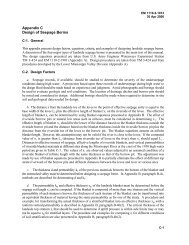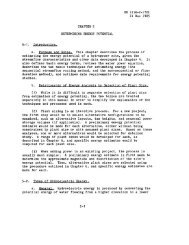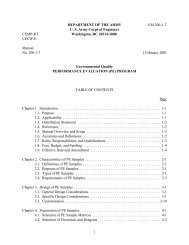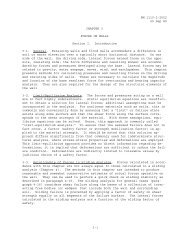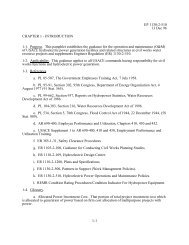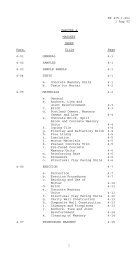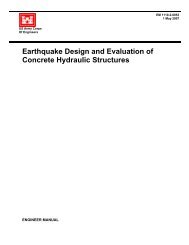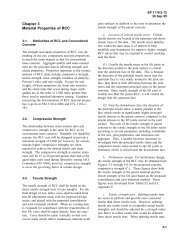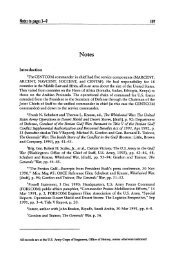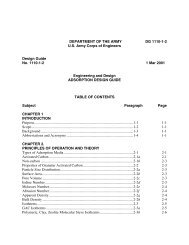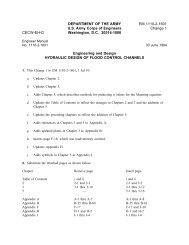em2901.chp:Corel VENTURA - Publications, US Army Corps of ...
em2901.chp:Corel VENTURA - Publications, US Army Corps of ...
em2901.chp:Corel VENTURA - Publications, US Army Corps of ...
Create successful ePaper yourself
Turn your PDF publications into a flip-book with our unique Google optimized e-Paper software.
EM 1110-2-2702<br />
1 Jan 00<br />
3-20<br />
1.4 3<br />
1<br />
H 2 + 1.2D + 1.6(C + M) + (1.2Q<br />
or 1.2Q<br />
)<br />
(3-11)<br />
For this case, the moderate hydrostatic load H2 is applied in combination with the maximum machinery<br />
load Q3 (for wire rope hoists or hydraulic hoists) or Q1 (for hydraulic hoists), and gravity loads D, C, and<br />
M exist. It is assumed that only one hoist is functional. In the determination <strong>of</strong> H2, the lower pool<br />
elevation will include a hydrodynamic reduction due to flow <strong>of</strong> water under the gate (must be coordinated<br />
with the project hydraulic engineer). The effects <strong>of</strong> H1, WA, I, or E are not considered for this load case,<br />
since it is assumed that the likelihood <strong>of</strong> the simultaneous occurrence one <strong>of</strong> these loads while the gate is<br />
jammed is negligible.<br />
(e) Load case 5: Gate fully opened. The load combination <strong>of</strong> Equation 3-12 accounts for the condition<br />
where the gate is fully opened (raised to the gate stops) with wind, earthquake, or operating equipment<br />
loads.<br />
k D D + 1.6(C + M) + (1.3W or 1.0E or 1.2 Q 3 ) (3-12)<br />
For this case, it is assumed that the gate is raised above the pool, so effects <strong>of</strong> H, WA, and I are not<br />
included. Effects <strong>of</strong> Q3 oppose gravity load effects, and effects <strong>of</strong> W or E may add to or oppose gravity<br />
load effects. When Q3 is considered, or when effects W or E oppose those <strong>of</strong> gravity, C and M should be<br />
equal to 0 and the load factor kD is equal to 0.9. When the direction <strong>of</strong> W or E is such that their effect<br />
increases gravity load effects, kD is equal to 1.2 and C and M should be considered.<br />
(f) Assumptions on support or loading <strong>of</strong> gate lifting systems (operating machinery). The load<br />
combinations included herein were developed for gate design based on various assumptions on loading and<br />
support conditions. (See Chapter 7 for discussion on criteria regarding load and operational requirements<br />
for operating machinery.) These assumptions must be considered in structural analysis <strong>of</strong> gate components<br />
(paragraph 3-5). For a tainter gate to be stable, rotational restraint must be provided by a suitable support.<br />
It is assumed that this support is the sill when the gate is closed (case 1), the hoists when the gate is<br />
operated (case 2 and case 3), the pier or some obstruction at the gate sides when the gate is jammed<br />
(case 4), and the hoists or the gate stops when the gate is fully opened (case 5). In load cases 2, 3, and<br />
some applications <strong>of</strong> 5, operating machinery loads Q are not included, since for these cases, the hoists are<br />
supports. The hoists provide reaction forces which are a function <strong>of</strong> all other gate loads. In load cases 1,<br />
4, and some applications <strong>of</strong> 5, where the gate is supported by something other than the hoists, any force<br />
exerted by the hoists is an external load on the gate Q.<br />
c. Limit states and design strength for individual members. EM 1110-2-2105 requires that strength<br />
and serviceability limit states be considered in the design <strong>of</strong> tainter gate structural components. Strength<br />
limit states include general yielding, instability, fatigue, and fracture. The design strength for each<br />
applicable limit state Rn is calculated as the nominal strength Rn, multiplied by a resistance factor and<br />
a reliability factor . Except as modified herein, limit states, nominal strength Rn, and resistance factors <br />
shall be in accordance with AISC (1994). For normal conditions, shall be equal to 0.9. For gates that<br />
are normally submerged and whose removal would disrupt the entire project, or for gates in brackish water<br />
or sea water, shall be equal to 0.85. Fatigue and fracture design requirements are included in paragraph<br />
3-8 and EM 1110-2-2105. Serviceability requirements for tainter gates are specified in paragraph<br />
3-6. The following paragraphs provide specific guidance for the design <strong>of</strong> skin plate, ribs, girders,<br />
and end frame members.<br />
(1) Skin plate. The skin plate shall be sized such that the maximum calculated stress is less than the<br />
yield limit state <strong>of</strong> bFy. In determining the required strength, all load cases in paragraph 3-4.b shall be




